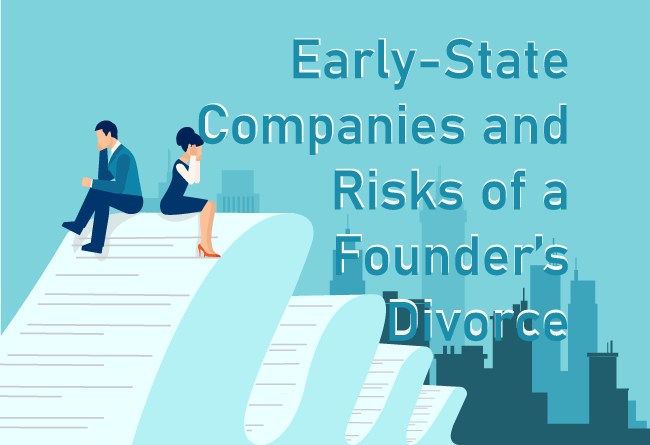The HBS Blog offers insight on Delaware corporations and LLCs as well as information about entrepreneurship, startups, cryptocurrency, venture capitalism and general business topics.
Protecting Your Business from the Risks of Founder Divorce
By
Jarrod Melson, Esq.
Tuesday, July 1, 2025
 Divorce is brutal, even at its most amicable. Company founders need to consider the risks that a business owner’s divorce presents to the company. In this new blog, we present common-sense considerations to take into account and outline the steps to mitigate the risk to the business as much as possible... Read More
Divorce is brutal, even at its most amicable. Company founders need to consider the risks that a business owner’s divorce presents to the company. In this new blog, we present common-sense considerations to take into account and outline the steps to mitigate the risk to the business as much as possible... Read More

What Is an LLC Operating Agreement?
By
Brett Melson
Monday, June 30, 2025
 The Delaware legislature created the limited liability company (LLC) in such a way as to allow the LLC's members the freedom to contract with one another upon whatever terms they deem are best suited to their company... Read More
The Delaware legislature created the limited liability company (LLC) in such a way as to allow the LLC's members the freedom to contract with one another upon whatever terms they deem are best suited to their company... Read More

Routine Filings that Clients Sometimes Neglect
By
Justin Damiani
Tuesday, June 17, 2025
 Some Delaware business filings need to be replicated when making a name change, dissolving a business or changing entity type. Learn more in our blog... Read More
Some Delaware business filings need to be replicated when making a name change, dissolving a business or changing entity type. Learn more in our blog... Read More

EIN Responsible Party for a Business Entity
By
Brett Melson
Monday, June 16, 2025
 When you apply for an EIN, also known as a Federal Tax ID Number, you will have to provide the IRS with what is known as a Responsible Party - an individual who manages, directs and/or controls the entity behind the EIN. Read our blog to learn more... Read More
When you apply for an EIN, also known as a Federal Tax ID Number, you will have to provide the IRS with what is known as a Responsible Party - an individual who manages, directs and/or controls the entity behind the EIN. Read our blog to learn more... Read More

Board Meeting Mistakes to Avoid: Part 4 of Delaware Board Meeting Series
By
Brett Melson
Tuesday, June 10, 2025
 This is Part 4 and the final installment of our comprehensive Delaware board meeting series. After covering the basics in Parts 1-3, we now address the most common mistakes that can expose companies to legal risk... Read More
This is Part 4 and the final installment of our comprehensive Delaware board meeting series. After covering the basics in Parts 1-3, we now address the most common mistakes that can expose companies to legal risk... Read More

How to Take Corporate Minutes
By
Brett Melson
Monday, June 9, 2025
 Delaware corporations should hold an annual meeting and take minutes. Not sure how to take corporate minutes? Here’s what you need to know... Read More
Delaware corporations should hold an annual meeting and take minutes. Not sure how to take corporate minutes? Here’s what you need to know... Read More

Dissolve a Corporation with Certificate of Dissolution
By
Jeremy Reed
Tuesday, June 3, 2025
 Some corporation owners do not want to pay the expense of filing a Certificate of Dissolution. There is an alternative to dissolving your corporation via Certificate of Dissolution—you can tell your Registered Agent to resign as the agent with the state... Read More
Some corporation owners do not want to pay the expense of filing a Certificate of Dissolution. There is an alternative to dissolving your corporation via Certificate of Dissolution—you can tell your Registered Agent to resign as the agent with the state... Read More

Calling and Holding a Board Meeting, Part 2
By
Brett Melson
Monday, June 2, 2025
 A Delaware Corporation's bylaws are crucial for outlining the operational framework and governance mechanics of a corporation, including the composition and procedures and rules regarding board directors and meetings. This is part two of our discussion on how board meetings are called and held in this two part blog series... Read More
A Delaware Corporation's bylaws are crucial for outlining the operational framework and governance mechanics of a corporation, including the composition and procedures and rules regarding board directors and meetings. This is part two of our discussion on how board meetings are called and held in this two part blog series... Read More

Think and Grow Rich Book Review
By
Devin Scott
Tuesday, May 27, 2025
 Read our book review for Think and Grow Rich by Napoleon Hill. Hill describes the main principles that some wealthy people follow to gain their wealth... Read More
Read our book review for Think and Grow Rich by Napoleon Hill. Hill describes the main principles that some wealthy people follow to gain their wealth... Read More

Pros and Cons to Running an LLC from Home
By
HBS
Monday, May 26, 2025
 Most people love the idea of working from home - but is it a good choice to run your LLC from home? Here are the pros and cons to running an LLC from home... Read More
Most people love the idea of working from home - but is it a good choice to run your LLC from home? Here are the pros and cons to running an LLC from home... Read More

